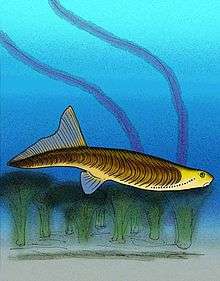Jamoytius
| Jamoytius Temporal range: Llandovery | |
|---|---|
 | |
| Scientific classification | |
| Kingdom: | Animalia |
| Phylum: | Chordata |
| Class: | Hyperoartia |
| Order: | Jamoytiiformes[1] |
| Genus: | Jamoytius |
| Binomial name | |
| Jamoytius kerwoodi White 1946[2] | |
Jamoytius kerwoodi was a species of primitive, eel-like jawless fish that lived in the Llandovery epoch of the Early Silurian period.
Long thought of as a "basal anaspid," J. kerwoodi is now recognized as the best-known member of the Hyperoartian order Jamoytiiformes. It had an elongated body, and is thought to have had, in comparison with relatives known from intact bodies like Euphanerops, a dorsal fin and an anal fin near the posteriormost third of its body. Earlier reconstructions depict the creature as having side-fins running the length of its body, starting from behind the branchial openings to the tip of its tail: new research demonstrates that such "fins" are actually deformations of the bodywall as the corpse was being squished post-burial.[1] In life, J. kerwoodi resembled a lamprey with a very small mouth. Because the fossil had no teeth, teeth-like structures, nor suggestions of either in its mouth, it was not carnivorous like many modern lampreys. It was more likely to have been a filter-feeder or a detrius-feeder, possibly in the manner of larval lampreys.
The fish had a cartilaginous skeleton, and a branchial basket resembling the cyclostomes - used to suggest that it was a near-ancestor to that clade. It is also the earliest known vertebrate with camera-type eyes.[3] It also possessed weakly mineralised scales.[4]
History of research
Jamoytius was originally named by Errol White on the basis of two specimens (the generic name is a reference to J. A. Moy-Thomas[5]) and, at the time, it was considered to be the most basal vertebrate known. Since then, it has been reclassified by many workers as having many different affinities, such as an "unspecialized anaspid",[6] or as a sister taxon to the lampreys,[1] its difficulty in classification due to difficulties in reconstructing the anatomy;[1] it does not possess any usual chordate synapomorphies. Currently, J. kerwoodi is now placed in its own order Jamoytiiformes, together with Euphanerops and similar agnathans.[1]
Further reading
- Long, John A. The Rise of Fishes: 500 Million Years of Evolution Baltimore: The Johns Hopkins University Press, 1996. ISBN 0-8018-5438-5
Links to images
References
- 1 2 3 4 5 Sansom, Robert S; Kim Freedman; Sarah E Gabbott; Richard J. Aldridge; Mark A. Purnell (2010). "Taphonomy and Affinity of an Enigmatic Silurian Vertebrate, Jamoytius Kerwoodi White". Palaeontology. 53 (6): 1393–1409. doi:10.1111/j.1475-4983.2010.01019.x.
- ↑ White, E.I. (March 1, 1946). "Jamoytius kerwoodi, a new chordate from the Silurian of Lanarkshire [Scotland]". Geological Magazine. 83 (2): 89–97. doi:10.1017/S0016756800082856. Retrieved 2007-10-31.
- ↑ Ritchie, A. (1968). "New evidence on Jamoytius kerwoodi White, an important ostracoderm from the Silurian of Lanarkshire, Scotland" (PDF). Palaeontology. 11: 21–39. Retrieved 2007-10-31.
- ↑ Today, G.; Blom, Henning; Märss, Tiiu (2003). "Fossils explained 43: Anaspid fishes". Geology Today. 19 (3): 111–113. doi:10.1046/j.1365-2451.2003.00413.x.
- ↑ Dawkins, Richard The Ancestor's Tale
- ↑ Ritchie, A. (1960). "A new interpretation of Jamoytius kerwoodi White".